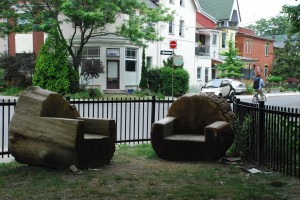September 16, 2013
Down with Princessery!

(This piece is cross-posted at Bunch)
With the end of summer, the kids have come home from fishing down at the proverbial crawdad hole, and are now settling back into gender roles as dictated by toy marketers, because let’s face it: our boys will be boys and our girls will be princesses.
But not so fast…
Listen, I’ve read my Peggy Orenstein, and I’ve got an opinion or two about the effects of “princess culture” on boys and girls alike. And so since before my daughter was born, I’ve been unabashedly brainwashing her with my own politics, a plan that has been foolproof so far*. A parent has to have a weapon or two in her bag to use against the big bad world, and these are the ones that have worked for me, but have also served as great reads at the very same time.
 Wonder Woman: The Story of the Amazon Princess by Ralph Cosentino: Wonder Woman is the third of Cosentino’s manga-style picture book introductions to classic comics. He tells the story of Diana, the Amazon princess who didn’t want to be just a princess, and chose to spend her life fighting for justice instead. My daughter remains curious about why Wonder Woman has to battle the forces of evil in her underpants, but as princess role models go, you could do worse than this one.
Wonder Woman: The Story of the Amazon Princess by Ralph Cosentino: Wonder Woman is the third of Cosentino’s manga-style picture book introductions to classic comics. He tells the story of Diana, the Amazon princess who didn’t want to be just a princess, and chose to spend her life fighting for justice instead. My daughter remains curious about why Wonder Woman has to battle the forces of evil in her underpants, but as princess role models go, you could do worse than this one.
 The Princess Knight by Cornelia Funke and Kerstin Meyer: Princess Violetta is raised in the same fashion as her big brothers, although they laugh at her futile efforts to mount a horse while wearing heavy armour. This makes her all the more determined to prove herself as brave and strong, so she begins sneaking out after dark and practicing a knight’s skills in her own way. She eventually becomes so adept that she ends up winning her own hand in marriage (long story) and thus is granted the independence she desires.
The Princess Knight by Cornelia Funke and Kerstin Meyer: Princess Violetta is raised in the same fashion as her big brothers, although they laugh at her futile efforts to mount a horse while wearing heavy armour. This makes her all the more determined to prove herself as brave and strong, so she begins sneaking out after dark and practicing a knight’s skills in her own way. She eventually becomes so adept that she ends up winning her own hand in marriage (long story) and thus is granted the independence she desires.
 Sir Cassie to the Rescue by Linda Smith and Karen Patkau: “Cassie read a story about knights…” this book begins, and when she finishes reading, Cassie tries to cajole her brother into a game of knights. Just one problem: neither of them is interested in being the damsel in distress. After trying out other options, and constructing a variety of marvelous castles in the living room, Cassie and her brother come up with an ingenious solution to their problem. And then Cassie opens a book about pirates, and her imagination starts running wild again…
Sir Cassie to the Rescue by Linda Smith and Karen Patkau: “Cassie read a story about knights…” this book begins, and when she finishes reading, Cassie tries to cajole her brother into a game of knights. Just one problem: neither of them is interested in being the damsel in distress. After trying out other options, and constructing a variety of marvelous castles in the living room, Cassie and her brother come up with an ingenious solution to their problem. And then Cassie opens a book about pirates, and her imagination starts running wild again…
 Olivia and the Fairy Princesses by Ian Falconer: At first glace, it looks like a Princess book, complete with tiara, magic wand and Olivia’s name in pretty pink. But a close look at Olivia’s facial expression reveals that this book will be an examination rather than a celebration of princess culture. Falconer is shameless in his anti-princess agenda, but the story is still funny for kids, and poses questions worth asking your sons and daughters: why are princesses so lacking in cultural diversity? And “If everyone’s a princess, then princesses aren’t special anymore… Why do they all want to be the same?”
Olivia and the Fairy Princesses by Ian Falconer: At first glace, it looks like a Princess book, complete with tiara, magic wand and Olivia’s name in pretty pink. But a close look at Olivia’s facial expression reveals that this book will be an examination rather than a celebration of princess culture. Falconer is shameless in his anti-princess agenda, but the story is still funny for kids, and poses questions worth asking your sons and daughters: why are princesses so lacking in cultural diversity? And “If everyone’s a princess, then princesses aren’t special anymore… Why do they all want to be the same?”
 The Paper Bag Princess by Robert Munsch and Michael Martchenko: I know you’ve read this one already, but it’s still so good after all these years. Standout lines are, “You look like a real prince but you are a bum” and the best and most genre-defying conclusion of any book ever: “They didn’t get married after all.” Final image is the spirited princess dancing off into the sunset, kicking up her heels, arms embracing the world.
The Paper Bag Princess by Robert Munsch and Michael Martchenko: I know you’ve read this one already, but it’s still so good after all these years. Standout lines are, “You look like a real prince but you are a bum” and the best and most genre-defying conclusion of any book ever: “They didn’t get married after all.” Final image is the spirited princess dancing off into the sunset, kicking up her heels, arms embracing the world.
 Princess Smarty Pants by Babette Cole: “Princess Smartypants did not want to get married. She enjoyed being a Ms.” In order to deal with the annoying throngs of suitors turning up at her door, she sets impossible tasks that defeat every one of them—until Prince Swashbuckle arrives. He manages to jump through every hoop she throws him, proving himself quite up to the job of winning her hand except for one thing: Prince Swashbuckle doesn’t think that Princess Smartypants is so smart. And it’s too bad for him: Smartypants turns him into a toad. Obviously, they didn’t get married after all either.
Princess Smarty Pants by Babette Cole: “Princess Smartypants did not want to get married. She enjoyed being a Ms.” In order to deal with the annoying throngs of suitors turning up at her door, she sets impossible tasks that defeat every one of them—until Prince Swashbuckle arrives. He manages to jump through every hoop she throws him, proving himself quite up to the job of winning her hand except for one thing: Prince Swashbuckle doesn’t think that Princess Smartypants is so smart. And it’s too bad for him: Smartypants turns him into a toad. Obviously, they didn’t get married after all either.
 And finally, someone needs to write a picture book about The Cockfighting Princess. Irina Walker, the third daughter of the exiled King of Romania, has been charged with running illegal cockfighting events in Oregon, even selling refreshments to spectators. This serves as a most important lesson for little girls everywhere: even cockfighting princesses are not above the law. And that princessing and glamour do not always go hand and hand.
And finally, someone needs to write a picture book about The Cockfighting Princess. Irina Walker, the third daughter of the exiled King of Romania, has been charged with running illegal cockfighting events in Oregon, even selling refreshments to spectators. This serves as a most important lesson for little girls everywhere: even cockfighting princesses are not above the law. And that princessing and glamour do not always go hand and hand.
*I know, I know. This is going to backfire at some point. But in the meantime, I want to provide my girl with a foundation that underscores the limitlessness to who she might possibly become as a human being.
September 15, 2013
We met Sheree Fitch. And that’s the least of it…
 They didn’t have Sheree Fitch when I was a little girl. But when Harriet was very small, someone gave us a copy of her board book Kisses Kisses Baby-O, and we loved it, its rhyme and rhythm, its simplicity and lovingness. Not long after, I learned that Sheree Fitch had written a novel for adults, called Kiss the Joy as It Flies; I read it for a few days in darkest January, and I remember how it lit up my life.
They didn’t have Sheree Fitch when I was a little girl. But when Harriet was very small, someone gave us a copy of her board book Kisses Kisses Baby-O, and we loved it, its rhyme and rhythm, its simplicity and lovingness. Not long after, I learned that Sheree Fitch had written a novel for adults, called Kiss the Joy as It Flies; I read it for a few days in darkest January, and I remember how it lit up my life.
I think we got Peek a Little Boo sometime after that, which fast became a favourite. Harriet loved the baby faces, we loved the song, and we changed the words so they said her name (“Amazing Harriet, how do you do? Happy Harriet, huggle-wuggle you!”) to hold her attention extra-fast.
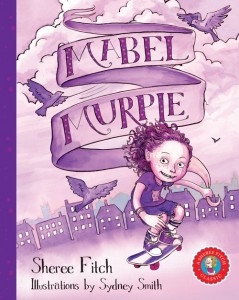 Around this time, Mabel Murple was being re-issued, which was immediately beloved and resulted in Harriet’s favourite colour being purple for some time (and the purple house on Brunswick Avenue is called “Mabel Murple’s house” still). We read this book regularly, as recently as last night, and also spend a lot of time talking about it and speculating about its extraneous story (like the shadow of Mabel’s mother which is visible on one page as Mabel gets in purple trouble).
Around this time, Mabel Murple was being re-issued, which was immediately beloved and resulted in Harriet’s favourite colour being purple for some time (and the purple house on Brunswick Avenue is called “Mabel Murple’s house” still). We read this book regularly, as recently as last night, and also spend a lot of time talking about it and speculating about its extraneous story (like the shadow of Mabel’s mother which is visible on one page as Mabel gets in purple trouble).
 We got Sleeping Dragons All Around, and while Harriet went through a period where she found it “too scary”, that was only temporary. She loves all things dragonish these days, and so the book is a favourite (and I would like to hang a plaque on my wall that says, “We dance in the kitchen! We don’t do the dishes”). Was Monkeys in My Kitchen next? I think so. We love that one too.
We got Sleeping Dragons All Around, and while Harriet went through a period where she found it “too scary”, that was only temporary. She loves all things dragonish these days, and so the book is a favourite (and I would like to hang a plaque on my wall that says, “We dance in the kitchen! We don’t do the dishes”). Was Monkeys in My Kitchen next? I think so. We love that one too.
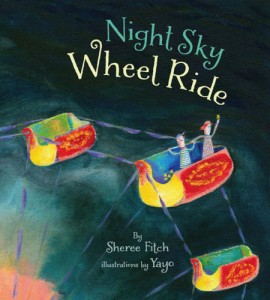 I had become online friends with Sheree by this point. (I interviewed her in 2010, and had also read her beautiful collection of poetry for adults, In this house are many women.) We were the lucky recipients of Night Sky Wheel Ride, which arrived in the post on Harriet’s third birthday. I remember literally dropping everything and sitting down to read it with her on our front step, and being amazed by it. “Can you hear the mermaids murmur/beluga whales sing/ feel the whirling stir/ of every little humming phosphorescent thing?” That line blows my mind every time I read it, which is often. Recently, we got If I Had A Million Onions, which is wonderful.
I had become online friends with Sheree by this point. (I interviewed her in 2010, and had also read her beautiful collection of poetry for adults, In this house are many women.) We were the lucky recipients of Night Sky Wheel Ride, which arrived in the post on Harriet’s third birthday. I remember literally dropping everything and sitting down to read it with her on our front step, and being amazed by it. “Can you hear the mermaids murmur/beluga whales sing/ feel the whirling stir/ of every little humming phosphorescent thing?” That line blows my mind every time I read it, which is often. Recently, we got If I Had A Million Onions, which is wonderful.
I am laying this all out to illustrate how Sheree Fitch has been a huge part of our family for Harriet’s entire life, which hasn’t been a long life (yet) but still an entire one (so far) which is not insignificant. In fact, Sheree Fitch is one of the things I kept in my pocket as we knew that Iris was coming, one of the parental things we’d have about immediately this time and which would make this babyhood oh so much better that it would be in a Fitchless world.
I am laying this all out because today something extraordinary happened: we met Sheree Fitch! We went to the Eden Mills Festival, which was lacking in sun but otherwise really lovely, and rain very nearly held off too. I managed to catch Saleema Nawaz reading after I had my lunch, but otherwise spent the afternoon in the kids’ area, partly because crying babies are better tolerated there, and also because the readers were wonderful–Aubrey Davis was a particular highlight.
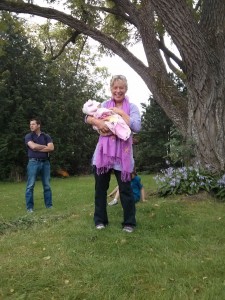 But then. Sheree Fitch. Dressed in purple (naturally). Who actually stole my crying baby and calmed her down while the rest of our family listened to readings. Sheree Fitch. In real life!! It was like meeting a rock star. Oh, I was so thrilled, but this was only the beginning.
But then. Sheree Fitch. Dressed in purple (naturally). Who actually stole my crying baby and calmed her down while the rest of our family listened to readings. Sheree Fitch. In real life!! It was like meeting a rock star. Oh, I was so thrilled, but this was only the beginning.
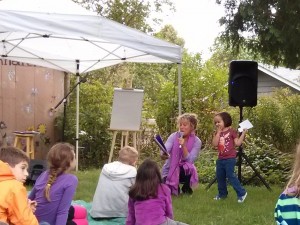 I took Iris back while Sheree took the stage to read Mabel Murple. And somehow, Harriet was standing beside her. Sheree began to read, and Harriet read along with her, the whole book memorized, finishing sentences, particularly emphatic upon her favourites: “I’m a purple person and I roar away my troubles!” “Skateboard scallywag, Mabel Murple’s on the loose (and they skedaddled)” And that purple teddy bear named Snickerknickerbox, who snored.
I took Iris back while Sheree took the stage to read Mabel Murple. And somehow, Harriet was standing beside her. Sheree began to read, and Harriet read along with her, the whole book memorized, finishing sentences, particularly emphatic upon her favourites: “I’m a purple person and I roar away my troubles!” “Skateboard scallywag, Mabel Murple’s on the loose (and they skedaddled)” And that purple teddy bear named Snickerknickerbox, who snored.
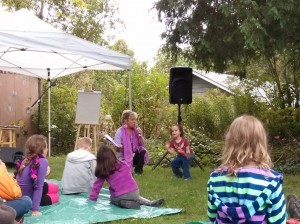 It was amazing. And not just because Harriet is someone I am particularly fond of, and because I am one half of the two people who have read her Mabel Murple 3000 times, but because it was wonderful to see, how Sheree’s joy is contagious, the generosity of her spirit, how her books performed aloud are more amazing than I ever expected (and my expectations were pretty high). Because a book can get so far into a little kid’s head, and because books are so incredible, and how wonderful are these days when we get to celebrate them together.
It was amazing. And not just because Harriet is someone I am particularly fond of, and because I am one half of the two people who have read her Mabel Murple 3000 times, but because it was wonderful to see, how Sheree’s joy is contagious, the generosity of her spirit, how her books performed aloud are more amazing than I ever expected (and my expectations were pretty high). Because a book can get so far into a little kid’s head, and because books are so incredible, and how wonderful are these days when we get to celebrate them together.
Because we met Sheree Fitch. And also because Harriet had her Eden Mills debut, which we certainly weren’t expecting. As I watched it all unfold, it was completely clear that this was one of the greatest things I would ever witness in my long, long joyful life.
September 11, 2013
Some thoughts about Sonali Deraniyagala’s Wave
 I recently read most of a very strange and fascinating novel by Jennifer Quist called Love Letters of the Angels of Death, a novel I had to ultimately quit because it was just a little too strange, mostly because the characters kept saying “dang” instead of swearing properly, and I just couldn’t get past that. But I was disappointed to run into trouble with the book because it really was remarkable in so many ways, and I keep bringing it up in conversations. Talking about this novel which is about a happy marriage, its curious second-person narration that makes so much sense upon the book’s conclusion (which I did read, though I skimmed bits in the middle), about how two people long-time married experience a kind of merger of self.
I recently read most of a very strange and fascinating novel by Jennifer Quist called Love Letters of the Angels of Death, a novel I had to ultimately quit because it was just a little too strange, mostly because the characters kept saying “dang” instead of swearing properly, and I just couldn’t get past that. But I was disappointed to run into trouble with the book because it really was remarkable in so many ways, and I keep bringing it up in conversations. Talking about this novel which is about a happy marriage, its curious second-person narration that makes so much sense upon the book’s conclusion (which I did read, though I skimmed bits in the middle), about how two people long-time married experience a kind of merger of self.
I thought of this book again this week as I read the stunning memoir Wave by Sonali Deraniyagala, when I encountered this line near the end of the book: “I often think I utter Steve’s words, not mine.” Steve, Deraniyagala’s husband who died in Sri Lanka along with their two sons, her parents and hundreds of thousands of others when the tsunami hit that country’s coast on December 26, 2004.
**
I remember that “tsunami” was once a word I looked up in the dictionary, not long before December 26, 2004. In the years since, while it has also become every headline-writer’s go-t0 metaphor, the event in its enormity has remained something of an abstraction, cemented in history. And yet born of that hugeness, born of so much death and sprawling awful, is Deraniyagala’s slim memoir, so spare and deliberate in its prose.
Wave is the book I thought I couldn’t bear to read, but then such a claim is sort of precious because I always wanted to, a peeking through my fingers as I hid my eyes sort of thing. I listened to Deraniyagala on CBC’s The Sunday Edition last winter one morning as I fried banana pancakes, and found the way she told her story so impressive. She was so articulate, interesting, and I found nothing shameful in being witness to her pain, the way I might have with a woman less in control of her own story.
***
“That Deraniyagala wrote down what happened is understandable. But why would some unconcerned individual, someone who has not been similarly shattered, wish to read this book? Yet read it we must, for it contains solemn and essential truths… In witnessing something far-fetched, something brought out before us from the distant perimeter of human experience, we are in some way fortified for our own inevitable, if lesser, struggles.” –Teju Cole
“Sometimes, usually when the weather is base and the freeways are black with ice and the commute takes too long, you try it on–my death. You take it in–shallow but still very much beneath your skin. It’s a tiny injection of grief and fear. It’s meant to protect us, like an inoculation. You stand in our kitchen as the sky outside gets darker, and you let this contrived, imaginary tragedy immunize you against real sorrow. In your imagination, you marshal the possibility of my death into the small, controlled sphere–one you hope cannot coexist in the same world as a truly dead one. It’s a bit like Halloween–playing dead, acting it out to keep real death away.” –Jennifer Quist, Love Letters of the Angels of Death
***
There are books I’ve read, Joan Didion’s Blue Nights and The Year of Magical Thinking, Calvin Trillin’s About Alice, books I’ve read imagining some sort of usefulness, that they might possibly “fortify me for my own inevitable sorrows”. But they won’t, of course. You can’t read up on this sort of thing, prepare for it. Instead it’s more like what Quist writes about, these vicarious griefs something that we try on, a kind of dare. But then we close the books, put them back on the shelf. Maybe it’s that we imagine they’re fortifying wherein lies the attraction. But they’re just not. They can’t be.
Though perhaps they help us better understand how life is, its shape, to glimpse its darkest corners. There is is usefulness in this, I suppose, deepening our vision of the world around us.
What makes Wave intriguing as compared to other memoirs and what makes it so profound is that instead of Deraniyagala casting herself as central character, she tells the story as filtered through her own perspective, what she sees and feels rather than who she is, or what she has become (though we do get a sense of that). She writes, “And I cringe to be bereft in a way that cannot be imagined, even though I do wonder how impossible this really is.” Her narrative exists to aid us in making that imaginative leap, in bridging the chasm between our experiences. Her self-effacement enhances this.
Though it is also a product of her tragedy–when she loses her family, Deraniyagala loses herself, and hers is the story of a reclaiming of her identity in the face of what has happened to her. So firmly anchored in her own perspective, we are to understand how time slows and spins in the immediate onset of grief, the confusion and the fury. She can’t bear to sleep for fear of waking and having to remember her loss all over again. She can’t bear to remember her family at all, can’t quite believe she ever had them, and it is years before she is able to return to their home in London, to confront what had been taken from her. The house is a museum, and she wants none of it disturbed. The pain of being there is overwhelming, and yet the pain of not having it to return to is worse. “I lost my shelter,” she writes, which seems to stand for everything.
This is the story of how she allows herself to remember her family and her love for them, to feel the pain of their loss because that pain is how she keeps them close to her. “I suspect that I can only stay steady as I traverse this world that’s empty of my family when I admit the reality of them, and me.” It take years for her to get to this point, and the book documents her journey closer and closer to the heart of the matter. And along the way, she brings her family back to life, her sons, her husband, her parents. She paints them each as distinct and striking characters, creating moments of levity that infuse her story with such light. It’s a story as sad as it is happy, what she lost underlined by what she had. Which doesn’t make it any easier that she doesn’t have it any longer, but neither are her loved ones thus entirely gone.
The key to this book, I think, and its usefulness for us, lies in a particular word that occurs at least twice. First, when she returns to her family’s London home and comes upon their back garden in early morning, the sight of a snail making its way across the patio table: “They would be so stirred by this.” Later, she writes about her husband who’d grown up on a council estate in East London, and his first trip to the Natural History Museum when he was six years old. At the sight of a life-sized model of a blue whale: “this was the most stirred he’d ever been.”
To be stirred then, to have our quiet disturbed. Perhaps this is why we should read this, or any book. A gentler version of Kafka’s frozen sea, and I like that. Not fortifying, but instead (and not merely) our reason for being.
September 10, 2013
Caution Against Any Recipe for Perfect Children
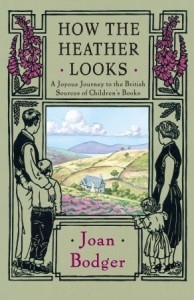 “I caution against any recipe for perfect children or for perfect families.” –Joan Bodger, “Afterword”, How the Heather Looks
“I caution against any recipe for perfect children or for perfect families.” –Joan Bodger, “Afterword”, How the Heather Looks
How the Heather Looks is one of my favourite books about parenting and children’s literature, mostly for the wisdom contained in its Afterword. On a surface level, the book itself is really an incredible primer on the lengths parents can go to to make books come alive for their children, as well as a splendid introduction to so many kid-lit classics. But if you didn’t read Bodger’s Afterword, or her extraordinary memoir The Crack in the Teacup, you might imagine that the idyllic 1950s’ family depicted in her book was her reality. Instead we learn that even limitless exposure to the greatest books ever written cannot keep trouble from darkening one’s doors. For some of us, that’s a difficult lesson to learn.
I’m thinking about this now as we’re struggling at our house with an unexpected and really difficult adjustment to kindergarten. I totally thought that we’d gotten off scot-free because Harriet has been in schooling for a year now, and has loved her play-school experience so much. When she began play-school last year, she shed nary and tear and ran along to play like she’d been there always, and I secretly thought that this was a reflection of her character and resilience, as well as my own infinite wisdom as a parent for enrolling her in schooling when the time was right, and for preparing her so well to be in the world. But the last few days have been a hearty Ha! to that idea.
Living a life is so difficult, and loving someone little who is making their way can be so gut-punchingly horrible. You can never be prepared for that, or prepare that little one for everything she might encounter. There is no recipe for a perfect childhood, and while I’d like to wrap the world in cotton-wool, I can’t, so instead I will keep on reminding myself that just loving her so hard is enough,
September 7, 2013
How the Light Gets In by Louise Penny
There is. Something. Something about the way Louise Penny writes. The style of her writing. The manner in which her sentences. Are formed. If I pay too much attention her prose makes me crazy, and yet I have so completely overcome these reservations that I am now the type who buys her book in hardback the day it comes out, as I did last week with How the Light Gets In. Such a delight for a book to be an occasion, and then to encounter neighbourhood friends who ask if I’ve finished it yet, who implore me to get in touch as soon as I do so we can talk about it. And when I finish the book, I understand why; How the Light Gets In is worthy of an occasion entirely.
Once again, we find ourselves back in Three Pines, the idyllic village in Quebec’s Eastern Townships so isolated that it doesn’t appear on any maps, where cellphone reception disappears, and to which murder is curiously common. They’ve got Chief Inspector Armand Gamache on speed dial there on their ancient rotary phones, a phone from which psychologist turned bookshop owner Myra Landers rings when an expected guest fails to arrive for Christmas holidays. Gamache is just days away from joining his wife for the holidays in Paris with their children, still dealing with desertion by his long-time friend and lieutenant Jean-Guy Beauvoir, and conscious that he’s a marked man by the corrupt forces high up in Quebec’s Surete police force. A trip out to Three Pines promises a reprieve, as the villagers grace him with their characteristic hospitality.
But as ever, the trip will be business, not pleasure. Gamache’s investigations reveal that Myra’s friend has been murdered, found dead in her home in Montreal. Myrna is loathe to reveal her friend’s deepest secret, which is that she was the last of the Oullette Quintuplets, five identical little girls who were once famous the world over. Could her background have something to do with her death?
Meanwhile, Gamache is still trying to unravel the web of corruption at the Surete. The few colleagues who are still loyal to him have come under threat through their investigations of the police department’s computer archives, and Gamache decides that Three Pines is the safest place for them to hide. Their investigations turn into a dramatic game of cyber-cat and mouse, culminating in a fantastic showdown between the forces of good and evil. Gamache has always believed that good will ultimately triumph, but this time will he be proven wrong?
What is the attraction of Louise Penny’s novels, my reservations with her prose still being what they are? I think part of it is the intimacy she creates, between reader and place in her remarkably evoked village of Three Pines. And also the intimacy between the characters themselves, so much between them that doesn’t need to be explained, allowing the novels to progress in ways that are surprising. And finally, the intimacy of her narrative, her shifting points of view which enable us to understand her world from a wide range of perspectives. Which is not to say that her readers know everything. In fact, in this book in particular, the plot is operating on a whole other plane that readers are not even aware of until an incredible twist at the conclusion, and I promise that you never see it coming.
On Penny’s website, she calls How the Light Gets In a culmination of the Gamache books so far, the pay-off. And while it really is a most fitting culmination, one can’t help hoping that it isn’t. As ever, Penny has left her readers wanting more.
September 4, 2013
Easing isn’t always easy
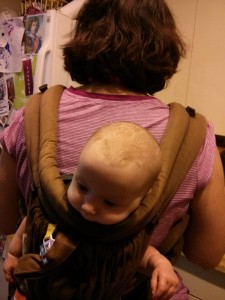 Oh, summer summer. This week we’re easing out of the bliss that was. Harriet starts kindergarten on Friday, she starts her afternoon play-school program tomorrow. Stuart goes back to work on Monday, and things look interesting on that front, plus he is taking a college course that starts next week. I am also easing back into my role at 49thShelf, and looking forward to some really cool projects this Fall. And Iris is still figuring out how to be in the world, though it helps that she knows how hands and fingers work. She is 13 weeks old today, 3 months old tomorrow, a second tooth just breaking through and making the nights hard. Starting Monday, I’m going to be taking care of her solo, which is a whole new ballgame.
Oh, summer summer. This week we’re easing out of the bliss that was. Harriet starts kindergarten on Friday, she starts her afternoon play-school program tomorrow. Stuart goes back to work on Monday, and things look interesting on that front, plus he is taking a college course that starts next week. I am also easing back into my role at 49thShelf, and looking forward to some really cool projects this Fall. And Iris is still figuring out how to be in the world, though it helps that she knows how hands and fingers work. She is 13 weeks old today, 3 months old tomorrow, a second tooth just breaking through and making the nights hard. Starting Monday, I’m going to be taking care of her solo, which is a whole new ballgame.
Today we tried out the backpack position in our Baby Trekker for the first time, and I am quite confident that it will be my liberation, by which I mean I will use to wear Iris while I make dinner and clean the house. She still takes her naps lying on my chest, and so nap-time will be me-time, by which I mean that I intend to get a lot of reading done. And I am writing these facts down here because really I’m just a bit anxious about settling into a new routine, a routine whose shape I haven’t glimpsed yet. I have a fantasy of dropping Harriet at kindergarten, Baby falls asleep in her stroller and then I head to a coffee shop to write for an hour. Though it’s probably more like 25 minutes, considering Iris’s naps. Fortunately, I have had a child before who naps for just 25 minutes, and it got better, so I am not so worried about this. I am confident the mix of working and taking care of Iris will figure itself out, but I am still not quite sure how this will happen.
I am routine-obssessed, as anyone who has ever tried to make plans with me on a Friday is well aware. (No thank you. On Friday afternoons, I clean my house, of course!) This is both a blessing and curse as a parent, the former because it gives an awfully chaotic universe a fundamental shape, and the latter because the shape is an illusion after all, and life requires flexibility. Not yet knowing what my routine will be is resulting in me creating manic posts like this one, and compiling lists like a mad-woman in the hope of feeling like I have some kind of a handle on it all. It is not yet clear that I do…
This transition from the bliss of summer has been nice. I am reading Louise Penny’s new mystery How the Light Gets In, which is so so enjoyable, the perfect kind of book with which to ease into anything. Perhaps I’ll even be able to post a review here in response, my first review in ages, because after a few weeks of summer reading, all the new releases I’ve been intending to talk about have failed to inspire much in me beyond a shrug. I keep blaming the books, but maybe I am too impatient right now. (With some of these I am being too generous though, and it is absolutely the book…)
So yes, transition is a fine thing, but I have never been good at transition. I think everything will be clearer when I’m right back in the thick of it.
September 3, 2013
How Television Saved My Life. Part Deux.
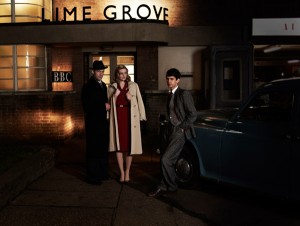 Once again, television came along this summer to make life with a new baby quite bearable. For the first six weeks of Iris’s life, every day was pretty much a mad scramble to 9:00 or so when we would sit down and take turns having the baby sleep on us while we delighted in excellent TV. We particularly loved watching the BBC drama The Hour, which was stylish, gripping and a stunning example of what female characters can be when women are writing them. In tragic news, the show was cancelled after two seasons, and left on a cliff-hanger. I have been pining for Freddy Lyon ever since.
Once again, television came along this summer to make life with a new baby quite bearable. For the first six weeks of Iris’s life, every day was pretty much a mad scramble to 9:00 or so when we would sit down and take turns having the baby sleep on us while we delighted in excellent TV. We particularly loved watching the BBC drama The Hour, which was stylish, gripping and a stunning example of what female characters can be when women are writing them. In tragic news, the show was cancelled after two seasons, and left on a cliff-hanger. I have been pining for Freddy Lyon ever since.
We also watched Girls, which I’d been nervous about. Somehow in all the politics and furor around the show, I’d neglected to understand that it was a comedy. Sometimes I wonder if its critics didn’t get that either. We are looking forward to watching Season 2.
And now we’ve just started watching Mad Men Season 6, having saved it for a time when our evenings were a little less chaotic. Oh, it’s so good. Season 5 was a bit of a let-down, though still pretty remarkable, as we affirmed as we re-watched it recently. (Because yes, I have basically just been watching Mad Men over and over for about 3 years now. It probably is a good thing that I finally watched another show.) But Season 6 really does seem to be a return to brilliant form.
August 30, 2013
Peach Pie in Progress
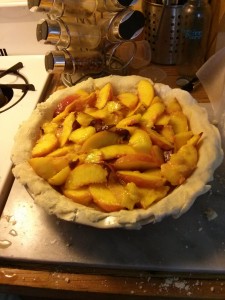 The best part of living with me is my insistence upon baking when it is 37 degrees outside. Pictured here is a pie in progress, peach, baked to be taken away on our trip this weekend with my best friend of 20 years and her wonderful family. (When they were just starting to be a family, I wrote about them here. There are three of them now in their family, all excellent.) And I am just checking in right now as we’re waiting to confirm that Iris really is asleep before we watch Mad Men. I had a really wonderful visit to the doctor’s today where it was pretty much confirmed that my career prospects for neck modelling are shot. I am to invest in turtlenecks and pretty scarves, and live with this lump as long as I possibly can. (I can’t help but feel that Nora Ephron had no idea; I also think that if I end up with as few years on earth as Nora Ephron, I am going not to spend none of them feeling bad about my neck no matter how lumpy or eventually scarred it becomes. The great thing about never having been particularly good looking in the first place is that you’re not really losing much when you start to be hideously disfigured.) My biopsy results were inconclusive, as there were so few solids in the sample, but as my lump is cystic, the doctor assures me that the chances of it being cancer are slim. I believe him. This lump will be an ongoing concern, but not so concerning, and anything “ongoing”, of course, means that I am not going to die. It also means that I have to stop getting so excited whenever I have it tested, because it’s going to happen every six months. And so it goes. This is life with a body. I feel very, very lucky.
The best part of living with me is my insistence upon baking when it is 37 degrees outside. Pictured here is a pie in progress, peach, baked to be taken away on our trip this weekend with my best friend of 20 years and her wonderful family. (When they were just starting to be a family, I wrote about them here. There are three of them now in their family, all excellent.) And I am just checking in right now as we’re waiting to confirm that Iris really is asleep before we watch Mad Men. I had a really wonderful visit to the doctor’s today where it was pretty much confirmed that my career prospects for neck modelling are shot. I am to invest in turtlenecks and pretty scarves, and live with this lump as long as I possibly can. (I can’t help but feel that Nora Ephron had no idea; I also think that if I end up with as few years on earth as Nora Ephron, I am going not to spend none of them feeling bad about my neck no matter how lumpy or eventually scarred it becomes. The great thing about never having been particularly good looking in the first place is that you’re not really losing much when you start to be hideously disfigured.) My biopsy results were inconclusive, as there were so few solids in the sample, but as my lump is cystic, the doctor assures me that the chances of it being cancer are slim. I believe him. This lump will be an ongoing concern, but not so concerning, and anything “ongoing”, of course, means that I am not going to die. It also means that I have to stop getting so excited whenever I have it tested, because it’s going to happen every six months. And so it goes. This is life with a body. I feel very, very lucky.
August 29, 2013
Destination Bookshop: The Annex/Harbord Circuit
Destination Bookshop is a new feature here at Pickle Me This! Part book-shopping-spree, part city travel guide, we want to inspire you to visit vibrant neighbourhoods all over Toronto with excellent bookshops as a chief attraction.
 This time we bring you a neighbourhood we know very well, because it’s where we live. And part of the reason we love where we live is because the bookshops are aplenty. Keep an eye out for writers too, because quite a few of them make their homes somewhere just off Bloor Street. One of them is poet Desi DiNardo who honours the neighbourhood and its literary legacy in her poem Rainbird in the Annex.
This time we bring you a neighbourhood we know very well, because it’s where we live. And part of the reason we love where we live is because the bookshops are aplenty. Keep an eye out for writers too, because quite a few of them make their homes somewhere just off Bloor Street. One of them is poet Desi DiNardo who honours the neighbourhood and its literary legacy in her poem Rainbird in the Annex.
 The Shops: Begin at Annex Book City (501 Bloor Street West), which is my favourite bookshop in the world. They have a great mix of new releases, backlists, a beautiful kids’ section, bargain books, lots of poetry, and a great focus on CanLit. Their staff are great, and knowledgeable, and the store is really organized. Next, move along to BMV Books (471 Bloor Street West) which sells discounted and second-hand books on three
The Shops: Begin at Annex Book City (501 Bloor Street West), which is my favourite bookshop in the world. They have a great mix of new releases, backlists, a beautiful kids’ section, bargain books, lots of poetry, and a great focus on CanLit. Their staff are great, and knowledgeable, and the store is really organized. Next, move along to BMV Books (471 Bloor Street West) which sells discounted and second-hand books on three  enormous floors. Go south at Spadina until you get to Ten Editions (698 Spadina Avenue at Sussex), a used-book store where you get to climb up a ladder to bookseek in a most romantic fashion. The store is a warren, sometimes frustratingly, but there is a great Can-Lit section in the back. Turn right at Harbord Street, where you will find a whole host of bookshops. Bakka Phoenix specializes in Sci-Fi and Fantasy, and is located at 84 Harbord. Wonderworks is across the street at 79 Harbord and is a new-age bookshop. Caversham Booksellers is at 98 Harbord, and bills itself as “North America’s largest mental health bookstore.” And then Parentbooks is located just before Bathurst Street in a cute little worker’s cottage at 201 Harbord. They have a fantastic kids’ book section, as well as books about pregnancy,
enormous floors. Go south at Spadina until you get to Ten Editions (698 Spadina Avenue at Sussex), a used-book store where you get to climb up a ladder to bookseek in a most romantic fashion. The store is a warren, sometimes frustratingly, but there is a great Can-Lit section in the back. Turn right at Harbord Street, where you will find a whole host of bookshops. Bakka Phoenix specializes in Sci-Fi and Fantasy, and is located at 84 Harbord. Wonderworks is across the street at 79 Harbord and is a new-age bookshop. Caversham Booksellers is at 98 Harbord, and bills itself as “North America’s largest mental health bookstore.” And then Parentbooks is located just before Bathurst Street in a cute little worker’s cottage at 201 Harbord. They have a fantastic kids’ book section, as well as books about pregnancy,  parenting, and kids with special needs. Go north on Harbord to Little Island Comics (742 Bathurst), a wonderful children’s bookstore featuring comics, graphic novels, and remarkably-illustrated picture books. (Their parent-shop The Beguiling is located around the corner, just west at 601 Markham Street.) A few doors up is A Different Booklist (746 Bathurst), “opening the door to gems of the Canadian cultural mosaic.” And then hit Seekers Books back up at 509 Bloor Street, featuring more second-hand fare and lots of great kids’ book in the big room at the back.
parenting, and kids with special needs. Go north on Harbord to Little Island Comics (742 Bathurst), a wonderful children’s bookstore featuring comics, graphic novels, and remarkably-illustrated picture books. (Their parent-shop The Beguiling is located around the corner, just west at 601 Markham Street.) A few doors up is A Different Booklist (746 Bathurst), “opening the door to gems of the Canadian cultural mosaic.” And then hit Seekers Books back up at 509 Bloor Street, featuring more second-hand fare and lots of great kids’ book in the big room at the back.
Where to Play: We recommend the recently refurbished Margaret Fairley Playground on Brunswick Avenue, south of Harbord at Ulster Street. Even if you haven’t kids in tow, the new park features huge armchairs carved from tree trunks that would be perfect to curl up and read in. We do not guarantee you won’t get splinters, however… There are also picnic tables if you bring a lunch (see below). Sally Bird Park on Brunswick north of Harbord is a tiny little park featuring play equipment for grown-ups. There is lots of space to roam and explore on the University Campus, just east of the neighbourhood. If it is raining, go hang out at the Spadina Road Library just north of Bloor Street at 10 Spadina Road. And do check out Gwendolyn MacEwen Park on Walmer Road just north of Bloor, which features lots of pigeons and a bust of the famous Canadian poet
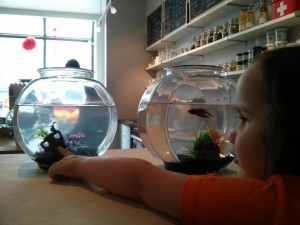 Where to Eat: We are partial to picking up a picnic lunch at Harbord Bakery (115 Harbord Street) and taking it to eat at Margaret Fairley Park. Or you can have lunch at By the Way Cafe (400 Bloor Street West), which has a lovely patio from where you can watch the world go by. Great ice cream too across Brunswick at Sweet Fantasies (398 Bloor Street, open only in the summer). Pick up a coffee and a snack at Red Fish Blue Fish Creative Cafe (73 Harbord Street). And if you’re craving something sweet, have a fancy tart from Dessert Trends Bistro (154 Harbord).
Where to Eat: We are partial to picking up a picnic lunch at Harbord Bakery (115 Harbord Street) and taking it to eat at Margaret Fairley Park. Or you can have lunch at By the Way Cafe (400 Bloor Street West), which has a lovely patio from where you can watch the world go by. Great ice cream too across Brunswick at Sweet Fantasies (398 Bloor Street, open only in the summer). Pick up a coffee and a snack at Red Fish Blue Fish Creative Cafe (73 Harbord Street). And if you’re craving something sweet, have a fancy tart from Dessert Trends Bistro (154 Harbord).
How to Get There: By transit, at Bathurst or Spadina stations. If you are driving, there is a Green P parking lot south of Bloor Street at Lippincott.



